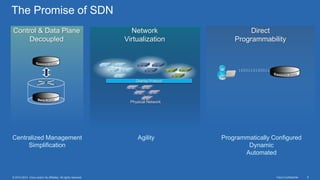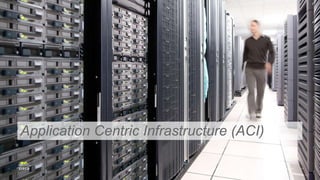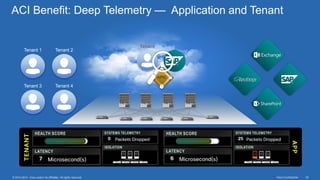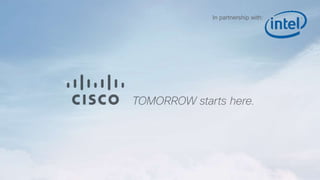Ad
The Data Center Network Evolution
- 1. Journey to the Programmable Fabric The Data Center Network Evolution Robert Zalobinski Technical Solutions Architect [email protected] In partnership with:
- 2. Cisco Confidential 2© 2013-2014 Cisco and/or its affiliates. All rights reserved. •Basics of SDN and Overlay Networks •Application Centric Infrastructure (ACI) •Virtual Topology System (VTS 2.0) •Unified Open NX-OS
- 3. Cisco Confidential 3© 2013-2014 Cisco and/or its affiliates. All rights reserved. What is SDN Software defined networking (SDN) is an approach to building computer networks that separates and abstracts elements of these systems In other words… In the SDN paradigm, not all processing happens inside the same device
- 4. Cisco Confidential 4© 2013-2014 Cisco and/or its affiliates. All rights reserved. Current Network Architecture Tightly coupled Control and Data Planes • One Control Plane per Device • Each Device Managed Individually • All Command Line Managed Routing protocols (i.e. OSPF, IS-IS, BGP), Spanning Tree, SYSLOG, AAA (Authentication Authorization Accounting), NDE (Netflow Data Export), CLI (Command Line interface), SNMP Layer 2 switching, Layer 3 (IPv4 | IPv6) switching, MPLS forwarding, VRF Forwarding, QOS (Quality of Service) Marking, Classification, Policing, Netflow flow collection, Security Access Control Lists cpu asic
- 5. Cisco Confidential 5© 2013-2014 Cisco and/or its affiliates. All rights reserved. The Promise of SDN Overlay Protocol Physical Network 10001101000110101 Control & Data Plane Decoupled Network Virtualization Direct Programmability Centralized Management Simplification Agility Programmatically Configured Dynamic Automated
- 6. Cisco Confidential 6© 2013-2014 Cisco and/or its affiliates. All rights reserved. SDN Programming Models Applications Control Data API ControllerAPI API Data ControllerAPI API Control Data vSwitchAPI Overlay Protocol Control DataOverlay Controller
- 7. Cisco Confidential 8© 2013-2014 Cisco and/or its affiliates. All rights reserved. Types of Overlay Edge Devices • Virtual end-points only • Single admin domain • VXLAN, NVGRE, STT • Physical and Virtual • Resiliency + Scale • Cross-organizations/Federation • Open Standards Network Overlays Integrated OverlaysHost Overlays • Router/switch end-points • Protocols for resiliency/loops • Traditional VPNs • OTV, VXLAN, VPLS, LISP App OS App OS Virtual Physical Fabric DB VM OS VM OS Virtual Virtual VM OS VM OS Physical Physical
- 8. Cisco Confidential 9© 2013-2014 Cisco and/or its affiliates. All rights reserved. VXLAN Overview Outer MAC DA Outer MAC SA Outer 802.1Q Outer IP DA Outer IP SA Outer UDP VXLAN ID (24 bits) Inner MAC DA Inner MAC SA Optional Inner 802.1Q Original Ethernet Payload CRC VXLAN Encapsulation Original Ethernet Frame CRC Data Plane 16 M Segments Control Information Tunnel Endpoints Discovery Host Reachability Information • Mac Address • IP address Draft Data Plane Multicast based flood and learn
- 9. Cisco Confidential 10© 2013-2014 Cisco and/or its affiliates. All rights reserved. Eth Eth Eth vEth vEth vEth vEth vEth vEth Overlay Network Communications - VTEP VXLAN utilizes a VTEP: • Virtual Tunnel End Point • IP address assigned • Layer-3 Transportable • IP/UDP Packets 10.10.10.101 10.10.10.211 172.18.22.12 Inter VXLAN communications VTEP VTEP VTEP
- 10. Cisco Confidential 11© 2013-2014 Cisco and/or its affiliates. All rights reserved. Eth Eth Eth vEth vEth vEth vEth vEth vEth Overlay Network Communications VXLAN 55110 VXLAN 45235 16m VXLANs VXLAN requires a network gateway function: • VXLAN to VLAN Bridge • VXLAN to VLAN Router • VXLAN to VXLAN Router VLANs
- 11. Cisco Confidential 12© 2013-2014 Cisco and/or its affiliates. All rights reserved. VXLAN54210 VXLAN Gateway Functions VXLAN55110 VXLAN45235 VLAN 235 VLAN 110 VXLAN55110 VXLAN45235 VXLAN55110 VLAN 235 VXLAN to VLAN Bridging (L2 Gateway) VXLAN-to-VXLAN Routing (L3 Gateway) VXLAN-to-VLAN Routing (L3 Gateway) VXLAN45235
- 12. Cisco Confidential 13© 2013-2014 Cisco and/or its affiliates. All rights reserved. Programmable NetworkProgrammable FabricApplication Centric Infrastructure DB DB Web Web App Web App VxLAN-BGP EVPN standard-based 3rd party controller support Modern NX-OS with enhanced NX-APIs Automation Ecosystem (Puppet, Chef, Ansible etc.) Common NX-API across N2K-N9K Turnkey integrated solution with security, centralized management, compliance and scale Automated application centric-policy model with embedded security Broad and deep ecosystem Cisco SDN: Providing Choice in Automation and Programmability Mass Market (commercial, enterprises, public sector) Service Providers Mega Scale Datacenters VTS for software overlay provisioning and management across N2K-N9K
- 13. Application Centric Infrastructure (ACI)
- 14. Cisco Confidential 15© 2013-2014 Cisco and/or its affiliates. All rights reserved. Two Types of Languages Infrastructure Applications Human Translator • Application Tier Policy and Dependencies • Security Requirements • Service Level Agreement • Application Performance • Compliance • Geo Dependencies • VLAN • IP Address • Subnets • Firewalls • Quality of Service • Load Balancer • Access Lists
- 15. Cisco Confidential 16©2014 Cisco and/or its affiliates. All rights reserved. Introducing: Application Centric Infrastructure Apps + Infrastructure Physical + VirtualOpen + Secure On-Premises + Cloud Application Oriented Policy = Operational Simplicity
- 16. Cisco Confidential 17© 2013-2014 Cisco and/or its affiliates. All rights reserved. Application Centric Infrastructure Components Fabric Centralized Policy Management Open APIs, Open Source, Open Standards Policy Controller Application Network Profile APIC End Points Physical Networking Nexus 2K Nexus 7K Hypervisors and Virtual Networking Compute L4–L7 Services Storage Multi DC WAN and Cloud Integrated WAN Edge Virtual Physical Northbound Management Integration Partner Ecosystem Automation OVM Hypervisor Management Monitoring Systems Management Orchestration Framework
- 17. Cisco Confidential 18© 2013-2014 Cisco and/or its affiliates. All rights reserved. Typical Three Tier Application Web Servers Firewall Server Load Balancer Access Switch Server vSwitch Firewall Access Switch App Servers Database Server Application Requirements tightly coupled to the Network Port Group, VLAN, IP Address, IP Mask Interface, Trunk, VLAN, IP Subnets Interface, Trunk, VLAN, IP Subnets • Network Connectivity • Security Policies • Quality of Service • Layer 4 – 7 Application Services • Storage Policies • Compute Policies • Hypervisor Policies
- 18. Cisco Confidential 19© 2013-2014 Cisco and/or its affiliates. All rights reserved. The Policy-based Datacenter IP Fabric • Single APIC Controller: • End-to-end Application Profile • ACI IP Fabric encompasses o Infrastructure o Physical o Virtual o Services • ANP Profile pushed to all components • Full Workload Mobility, Replication and Instantiation Application Network Profile Web Servers App Servers Database Server
- 19. Cisco Confidential 20© 2013-2014 Cisco and/or its affiliates. All rights reserved. ACI Benefit: Deep Telemetry — Application and Tenant APIC APP TENANT Tenant Tenant 1 Tenant 2 Tenant 3 Tenant 4
- 20. Cisco Confidential 21© 2013-2014 Cisco and/or its affiliates. All rights reserved. Application Approach To Networking F/W DB DBDecouple Policy from Infrastructure Simple & Scalable Stateless Infrastructure Optimized Forwarding & Mobility Abstracted Policies for definition of Applications & Connectivity Open REST APIs Centralized Management Open Source APIC Application Network Profile F/W F/W F/W STORAGE STORAGE WEB DBAPP Highest Performance & Reliability Lowest Power Consumption
- 21. Virtual Topology System (VTS)
- 22. Cisco Confidential 23© 2013-2014 Cisco and/or its affiliates. All rights reserved. Programmable Fabric NX-API, VXLAN BGP EVPN Fabric, and Virtual Topology System (VTS) Operations / Programmability & Automation Automated DCI / WAN VM OS VM OS NX-API Physical Virtual DCI/WAN Bare Metal Virtualized BGP-EVPN VXLAN Fabric VTS VTS for overlay provisioning and management across Nexus 2000 – Nexus 9000 (2H 2015)
- 23. Cisco Confidential 24© 2013-2014 Cisco and/or its affiliates. All rights reserved. vCenter REST API VTS GUI Across Nexus Portfolio Nexus 2K – 9K Programmable Fabric Automated Seamless integration with Orchestrators Overlay provisioning and DCI/WAN integration Scalable VXLAN Management MP-BGP EVPN control plane High performance virtual forwarding Open and Programmable REST Northbound APIs Multi-protocol and Multi-hypervisor support Virtual Topology System (VTS) Overlay Provisioning & Management System Flexible Overlays Physical and virtual overlays Bare-metal and Virtualized workloads
- 24. Cisco Confidential 25© 2013-2014 Cisco and/or its affiliates. All rights reserved. VXLAN as Data Center Overlay technology VTEP Local LAN Local LAN Local LAN Local LAN IP Transport Network VTEP VTEP VTEP VXLAN VNI LAN Segment Underlay Network: • IP routing – proven, stable, scalable • ECMP – utilize all available network paths Overlay Network: • Standards-based overlay • Layer-2 extensibility and mobility • Expanded Layer-2 name space • Scalable network domain • Multi-Tenancy Modes of Operation: • Multicast based flood and learn (No control plane) • BGP EVPN (BGP control plane with MP-BGP Extensions)
- 25. Cisco Confidential 26© 2013-2014 Cisco and/or its affiliates. All rights reserved. Advantages with EVPN Control Plane Industry standard protocol for multi-vendor support Built-in Multi tenancy support Truly scalable with protocol-driven control plane architecture Fast convergence upon network failures and host movements Minimize flooding through ARP suppression Security through VTEP peer-authentication AdvantagesofEVPN ControlPlane
- 26. Cisco Confidential 28© 2013-2014 Cisco and/or its affiliates. All rights reserved. VTF Cisco Network Services Orchestrator VMware vCenter GUI DVS Unified Information Model (REST API) YANG CLI NX-API BGP-EVPN Virtual Topology System Service and Infrastructure Policy Inventory Database Resource Management PolicyPlaneControl Plane IOS XRv Device Management Control Plane Federation MP-BGP Cisco Nexus 2000, 3000, 5000, and 7000 Series Cisco Nexus 9000 Series Cisco ASR 9000 Series Virtual Compute Environment VTS Architecture
- 27. Cisco Confidential 29© 2013-2014 Cisco and/or its affiliates. All rights reserved. VTS Architecture Cisco VTS ToR ToR Spine Spine ToR Hypervisor VM x86 Server Hypervisor VM x86 Server Hypervisor VMVM x86 Server REST API DCI NX-API, CLI, YANG VTEP VTEP VTEP Border Leaf VTEP VMware vCenter Virtual Topology System Service and Infrastructure Policy Inventory Database Resource Management PolicyPlaneControl Plane IOS XRv Device Management
- 28. Cisco Confidential 30© 2013-2014 Cisco and/or its affiliates. All rights reserved. VTS Architecture – Hardware Switches ToR ToR Spine Spine ToRVTEP VTEP Cisco VTS Hypervisor VM x86 Server Hypervisor VM x86 Server Hypervisor VMVM x86 Server REST API DCI NX-API, CLI, YANG VTEP Border Leaf VTEP VMware vCenter
- 29. Cisco Confidential 31© 2013-2014 Cisco and/or its affiliates. All rights reserved. VTS Architecture - VTF Cisco VTS ToR ToR Spine Spine ToR Hypervisor VM x86 Server Hypervisor VMVM x86 Server REST API DCI NX-API, CLI, YANG VTEP VTEP Border Leaf VTEP VMware vCenter Hypervisor VM x86 Server VTEP vSwitch vSwitch VTF (VM) Tenant VM Tenant VM vSwitch VTF (VM) Tenant VM Tenant VM KVMESXi NIC NIC User space, Multi-tenant, line rate packet forwarder Uses Vector Packet Processing technology Fully integrated with Intel DPDK Supports VXLAN, can be extended to support MPLSoGRE, L2TPv3, MPLSoUDP, native MPLS and SR Programmed by VTS using Restconf/YANG
- 30. Cisco Confidential 32© 2013-2014 Cisco and/or its affiliates. All rights reserved. VTS Functionality • Discover ToRs, Servers and interconnections • Manage switch and network topology status • Topology information via API or GUI Discovery • VXLAN Provisioning (BGP EVPN & Flood/Learn) • VXLAN Overlay management (Add/Modify/Delete) • Multi-tenancy support • Track and Update VNIDs as VM moves • Network facing resource management Provisioning • Tenant to VNID mappings and VNID status • VNID to VTEP mappings • VTEP to VLAN and end host mapping • Trace VMs connected to VTEP • VTEP status within a VNID • VXLAN and fabric statistics Overlay Visibility
- 32. Cisco Confidential 34© 2013-2014 Cisco and/or its affiliates. All rights reserved. ExtensibilityAuto Deployment Options Open Application Integration Programmability Tool Choice DevOps Enabling POAP NXAPI Yocto SDK Standard Open Interfaces Open Interfaces Automation and Visibility Adaptable NXOS Adaptable SDK ProgrammableBootStrap and Provisioning BootStrap/ Provisioning Package and Application Management Native Application Integration PXE Data Models Server Management Tools OPEN NX-OS - Extensible, Open, Programmable 34
- 33. Cisco Confidential 35© 2013-2014 Cisco and/or its affiliates. All rights reserved. Open NX-OS: Infrastructure Layer Enhancements 35 OPEN BOOTLOADERS & PROVISIONING OPEN PACKAGE/APPLICATION INTEGRATION OPEN INTERFACES OPEN OBJECT BASED API’s (NX-API, Model Driven) Open NX-OS consistent across both ToR and Modular Open NXOS
- 34. Cisco Confidential 36© 2013-2014 Cisco and/or its affiliates. All rights reserved. VTEP VTEP VTEP VTEP • Leverage existing compute deployment infrastructure (PXE/iPXE) for operationalizing NX-OS • Deploy NX-OS from a web server via HTTPS or TFTP server with support for both IPv4 and IPv6 • NX-OS CLI option added to select boot option either <bootflash(default) > or <pxe> Boot Server(DHCP & HTTP/TFTP) NX-OS Image Repository DHCP DISCOVER(v4/v6) IP Address & File/Image URL TFTP GET FILE/HTTP URL http://n9k- dk9….bin.. Validate Image Checksum & Boot Open NX-OS Bootloaders & Provisioning iPXE 36
- 35. Cisco Confidential 37© 2013-2014 Cisco and/or its affiliates. All rights reserved. • Ability to third party packages in Secure Guestshell or natively in NX- OS kernel • Install all third party applications (Puppet/Chef, etc) as RPMs • Daemon managed via standard Linux interfaces • Built-in support for YUM package manager • Patching and upgrade using standard rpm/yum workflows • NX-OS processes(BGP) can be upgraded/patched via “yum update” 37 Package as RPM C app with standard Linux constructs Open Embedded 64 bit Build Environment Cisco/Local Repository RPM local repository RPM upload YUM Install Linux Daemon Linux Kernel • Raw Socket • Netdevs • Libpcap init.d Monitoring server ASIC Build Server Target Switch Open NX-OS Package Management via YUM/RPM LXC and Native Daemons
- 36. Cisco Confidential 38© 2013-2014 Cisco and/or its affiliates. All rights reserved. • Leverage Linux command toolkit for monitoring configuration and troubleshooting • # tcpdump -w file.pcap -i eth1-1 • Use ethtool to display detailed interface statistics: • #ethtool –S eth2-1 • Use ifconfig to change mtu for an interface to jumbo MTU: • #ifconfig eth2-1 mtu 9000 • Use ip route to add a static route for a given interface: • #ip route add 203.0.113.0/24 via 198.51.100.2 dev eth2-1 • Leverage bash for NX-OS scripting automation • vsh –c “show interface brief” | grep up | awk/sed 38 Open NX-OS Linux Interfaces Bash Access
- 37. Cisco Confidential 39© 2013-2014 Cisco and/or its affiliates. All rights reserved. 39 • Tool provides a convenient way for network engineers to get up to speed with scripting and automation via web browser interface • Available on all Nexus platforms. • CLI commands embedded in structured input and output (JSON/XML) via HTTP/HTTPS • Use “feature nxapi” to enable access on the platform Open NX-OS Programmability NX-API Developer Sandbox
- 38. Cisco Confidential 40© 2013-2014 Cisco and/or its affiliates. All rights reserved. Updates on Nexus Portfolio Offerings Programmable Network Application Centric Infrastructure NEW! Unified Open NX-OS Release for Nexus 3000 and Nexus 9000 (Q3 2015) • Enhancements to NX-API – object store and model driven • Native 3rd party RPM applications integration (tcollector, Nagios, Ganglia, Puppet / Chef etc.) • Linux utilities support for seamless tool integration across compute and network • SDK for custom application integration NEW! ACI Release for Nexus 9000 (Shipping June 2015 ) • Microsoft Azure and System Center Integration • Programmability examples: vCenter plug-in, ACI toolkit etc. • Simplified operations • Stretched fabric, multiple destinations from 30KMs to 150KMs • Group-based policy on Openstack • New ACI ecosystem partners (CliQr) DB DB Web Web App Web App NEW! Common NX-API across N2K- N9K (2H 2015) Programmable Fabric NEW! Virtual Topology System (VTS) for software overlay provisioning and management across for Nexus 2K-9K (2H 2015) • Standards-based fabric support on Nexus 5600/7x00 with VXLAN BGP EVPN (shipping with Nexus 9000 today) VTS
- 39. Cisco Confidential 41© 2013-2014 Cisco and/or its affiliates. All rights reserved. Nexus 9000® Series Your Deployment, This Makes it Happen! Cisco Nexus 9300 Platform Fixed Switches NX-OS and ACI Choice of Fabric Architectures Feature Consistency with Silicon Innovations Cisco Nexus 9500 Platform Modular Switches Nexus 9516 – Best of Interop Data Center 2014 APIC – Best of Interop SDN 2015
Editor's Notes
- #16: This scripted slide is part of the Simplified IT - core ACI “Easy” message. If seen by itself, the script might not make sense. Animated Slide: YES To deploy applications, we need to deal with two different set of languages. Those of the application people and those of the network/infrastructure people. The key to remember is that the business needs information/data which is delivered by applications. The applications themselves depend amongst other things on network infrastructure, but the business doesn’t need or care about the network infrastructure itself. When applications need to be deployed they talk about certain aspects of the application – they use their own jargon/terminology. They talk in tiers, in availability, in compliance and in availability. The infrastructure language is very different. To deploy the application, the network team needs to know about VLAN’s, subnets, ACL’s, firewall rules, loadbalancing rules. There is a massive mismatch, and it is solved by human translation. The network infrastructures teams hopefully translate the requirements correctly… if not, there will be a second and third round of discussions, re-configuration until the translation is done in a way the application can run. Fun fact you could mention: Did you know that the network infrastructure teams have lots of ways to say “NO” without actually using that word? We ask questions that the application teams don’t know how to answer with the end-result being the application teams end up with actions and the network teams don’t have to do things yet (“which VLAN’s would you like”, why do you need 3 VLANs? Do you need me to enable ACL port 443 or port 80? ETC). If we don’t want to be stuck with an action, just ask a question Taking away this human translation problem is one of the things we are trying to solve. Getting to a new way of describing connectivity that is driven from the right of this slide, not the left. Not via CLI, not only Software Defined, but Policy Driven and Application Centric Note: These are the term used in the last slide. Nice to mention them here and to recap in the last slide
- #17: This scripted slide is part of the Simplified IT - core ACI “Easy” message. If seen by itself, the script might not make sense. Animated Slide: NO Cisco introduced Application Centric Infrastructure (ACI) publicly in November 2013 and we started shipping ACI to customers in August 2014. There are a number of key characteristics that form the foundation of ACI that I would like to introduce you too now. Apps + Infra: ACI is focused on an Applications infrastructure needs, not just about forwarding packets. For the first time a network understands that the packets it is forwarding belong to applications and for the first time a network can provide application relevant information about the applications infrastructure behavior/needs. We have built ACI around the infrastructure needs of applications. Physical and Virtual: The new DC networks (or fabrics as we started calling them) have changed in that while there are now much more virtual workloads that need to be supported the actual number of physical servers still large and is not projected to go down in numbers. Also the new way of developing applications (DevOps, Agile, distributed) has changed the communication needs from mainly north-south to mainly east-west (more on that later). That impacts the physical requirements of a new DC network or fabric, but more on that later. They key message here is that physical systems play a critical role in most customers business environments (and don’t forget, VM’s run on hypervisors which run on physical servers). ACI delivers network infrastructure connectivity to both virtual and physical workloads EQUALLY. Secure: ACI is built from the ground up with security and multi-tenancy in mind. Todays DC network has a default policy that allows end points (workloads) to communicate unless there is a specific configuration that forbids it. It is open from a security perspective. ACI fundamentally changes the security level as the default policy is to deny communication between end points (workloads) unless there is a specific policy that allows it. (Note: I’m specifically not mentioning more about security at this stage, there is specific Security slide coming later). Open: Open is top of mind in many of our customers conversations with us. Open protocols, open source, open programing interfaces etc… ACI is designed to be open. Open with regards to a single API that can be used to talk to ACI. Open with regards to the protocols used inside the ACI fabric, Open with regards to the eco-system and the protocol used to distribute policy (Note: I’m specifically not mentioning OpFlex at this stage yet, just want to set the scene for open, to have a more detailed follow-up conversation later in the presentation) OnPrem and Cloud: (note: Of the 4 points this is the least tangible for now, decide if you want to cover this or not) ACI can be deployed on premises by enterprises and services providers. It is multi-tenant and secure by design. We see ACI as the fabric foundation for cloud offerings, both private On-Prem as well as Cloud. Cisco has introduced the Cisco Global Intercloud, an initiative to build the worlds largest cloud of clouds, together with our service provider partners. The foundation that the Global Intercloud is build upon is ACI. OnPrem and Cloud: A significant portion of customers have moved to Converged Stacks, and in the most recent Gartner Magic Quadrant, Cisco is represented in the leaders quadrant twice, with the Vblock and FlexPod offerings. Both of these converged stacks have announced support for ACI enabled Converged Stacks.
- #21: One of the core design principles behind ACI was to provide complete visibility into the infrastructure – physical and virtual. Cisco APIC is designed to provide application and tenant health at a system level by using real-time metrics, latency details, atomic counters, and detailed resource consumption statistics If you application is experiencing performance issues, you can drill down easily into the lowest possible granularity – be it at a switch level, line card level, port level. We have atomic counters – That essentially enable you to get consistent view of your counters anywhere within the fabric. The holistic approach to correlate virtual and physical and tie that intelligence at an application or tenant level ensures that troubleshooting becomes extremely simple across your infrastructure, through a single pane of glass



















































































































































